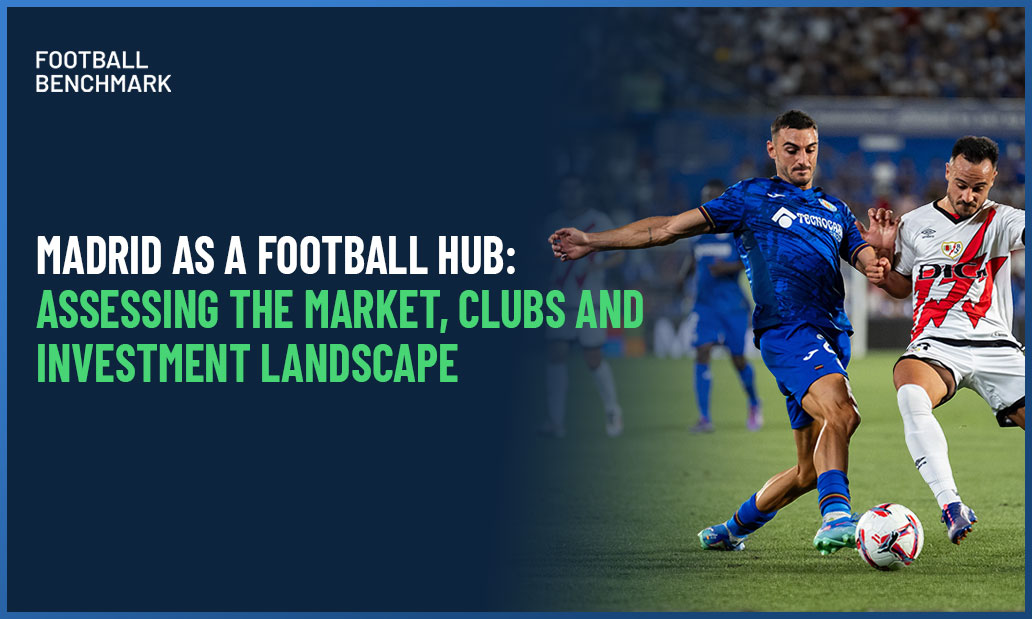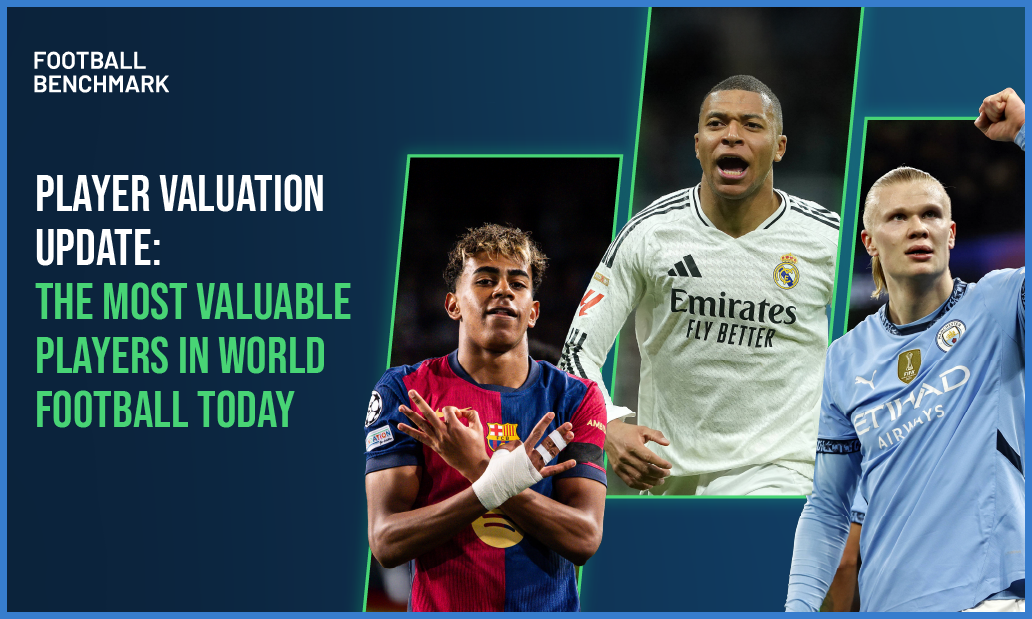
In recent years, a growing number of investors have begun looking beyond the traditional football giants, turning their attention to clubs based in major football cities. These urban centres, rich in history, talent, infrastructure, and commercial potential, offer compelling upside for strategic investment. The density of football activity in such cities makes them natural hubs for talent development and operational synergies, while their visibility and accessibility help attract players, staff, and commercial partners. Moreover, proximity to major clubs opens the door for cooperation models and access to broader football ecosystems. As a result, second- and third-tier clubs located in major football centres are increasingly viewed as valuable entry points into the game.
Madrid is one of the world’s most iconic football cities. It is home to two of the game’s biggest names in Real Madrid CF and Club Atlético de Madrid, competing in one of the most successful footballing nations and commercially attractive leagues. But beyond these global brands, the Spanish capital is also home to a cluster of smaller professional clubs that together form a dense and highly competitive football ecosystem.
This article explores the capital’s football economy, as interest continues to grow in the broader opportunities within the Madrid football market. How are the city’s other professional clubs performing, both commercially and on the pitch, and where might future growth potential lie within this increasingly dynamic landscape?
Snapshot of the club landscape
In 2024/25, five clubs from the Madrid region competed in LaLiga — a level of top-flight representation only matched once in the past 25 years, during the 2018/19 season. Further down the pyramid, clubs such as AD Alcorcón, CF Fuenlabrada, and Rayo Majadahonda, currently competing in the third and fourth tiers, have all featured in the Segunda División in recent seasons.
The disparities between Madrid’s clubs are clear. Real Madrid and Atlético de Madrid dominate across all metrics, from sporting success and global reach to infrastructure and commercial performance. Yet, investor interest across the wider region continues to rise.
At the top end, both Real Madrid and Atlético remain attractive targets in strategic terms, with significant perceived upside still to be unlocked, despite their contrasting ownership and governance models. However, for the purposes of this analysis, it is particularly relevant to explore the growing interest beyond the two giants. Getafe CF has been repeatedly linked to potential takeovers, including by Fenway Sports Group, owners of Liverpool FC, as part of a broader multi-club strategy. Meanwhile, CD Leganés and AD Alcorcón have already attracted foreign investment and are now integrated into established multi-club ownership networks.
Other investors continue to scan the market for clubs further down the pyramid within the Madrid metropolitan area, seeking to replicate the success of these recent acquisitions and tap into the region’s deep footballing foundations.
Attendance and revenue performance
A typical challenge for clubs based in major football hubs is building and sustaining fanbases in the shadow of local giants that dominate attention locally, nationally, and globally. Within this context, it is important to assess the ability of Madrid’s other clubs to attract consistent support and build meaningful engagement with their communities.
Madrid-based clubs outside the traditional giants consistently fall short of key attendance benchmarks. LaLiga’s average attendance, excluding the top three clubs, stands at nearly 25,000, almost double that of LaLiga2, which averages around 13,000. In 2024/25, Rayo Vallecano averaged 12,879 spectators per match, Getafe 11,469, and Leganés 11,135. All three figures fall not only below the LaLiga average, but also below the second-tier average, despite the clubs' location within a large and well-connected metropolitan area.
These clubs often rely on strong neighbourhood or municipal identities to attract fans, representing specific parts of the city or the greater metropolitan area rather than drawing from Madrid’s population as a whole. All three play in municipality-owned stadiums with capacities generally aligned to their realities, as reflected in utilisation rates: Rayo Vallecano (88%), Leganés (89%), and Getafe (68%).
Their long-standing presence in the professional game distinguishes them from other Madrid-area clubs with more limited top-tier experience and even more modest fanbases. For example, during their most recent season in LaLiga2 (2022/23), AD Alcorcón averaged just 2,839 spectators per match at their 5,100-capacity stadium. Rayo Majadahonda, during their 2018/19 campaign in LaLiga2, split home matches between their regular ground, Atlético Madrid’s training complex, and the Metropolitano Stadium, averaging just 3,367 spectators across the season.
These dynamics are clearly reflected in the financial performance of Madrid’s mid-tier clubs, particularly when broken down into matchday and commercial revenues.
Matchday revenue figures reinforce the patterns observed in attendance. In the 2023/24 season, Getafe generated €3.8 million in matchday income, while Rayo Vallecano brought in €4.2 million — both well below the LaLiga average of €12.7 million, even when excluding Real Madrid, Barcelona, and Atlético de Madrid.
In LaLiga2, Leganés reported just €1.7 million in matchday revenue. For context, Real Zaragoza and Real Oviedo, both long-established clubs in less saturated football markets with larger stadiums, brought in €6.1 million and €5.4 million, respectively. Clubs such as SD Eibar (capacity: 8,164), CF Eldense (5,776), and FC Cartagena (15,105) each generated around €1.6 million, broadly in line with Leganés. These figures suggest that limited stadium capacity, modest attendance, and constrained fanbase growth translate directly into constrained revenue potential, despite the clubs’ presence in one of Europe’s largest cities.
Commercial revenue shows a similar trend. In 2023/24, Getafe reported €7.5 million in commercial income and Rayo Vallecano €6.9 million, both significantly below the LaLiga average of €17.7 million (excluding the top three clubs). Whereas Leganés brought in €4 million commercially, compared to Real Valladolid, which recorded €13.6 million, and Real Oviedo, €7.4 million, both operating as the primary professional clubs in their respective cities.
These Madrid clubs, despite operating in a major metropolitan area, struggle to tap into the local economy in the same way that regionally dominant clubs often do in smaller cities or provinces. With limited brand visibility and a secondary status in their own city, they face structural limitations in attracting sponsorship, driving local engagement, and monetising their identity. In many respects, their commercial profile is closer to that of small-city clubs with strong regional followings than to peers within global football capitals.
These figures highlight the steep challenge smaller clubs face in carving out visibility and relevance within one of the most competitive football markets in Europe, where fans have access to elite-level football and a broad range of alternative entertainment options. Even for clubs with a long-standing presence in the professional game, commercial underperformance remains a recurring theme. Meanwhile, newer entrants — clubs now striving to establish a stable position in the professional tiers — face an equally difficult path, often lacking both infrastructure and historical fan affinity.
League performance and talent pathways
Despite the challenges outlined above, the data points to the gradual consolidation of a robust professional football hub within the Madrid metropolitan area, with several clubs maintaining a strong and consistent presence in Spain’s top tiers beyond the city’s two global giants.
Since the early 2000s, Getafe have firmly established themselves in the top flight, suffering just one relegation in the past 15 years and achieving immediate promotion in response. Rayo Vallecano have similarly maintained a relatively stable LaLiga presence, never spending more than two consecutive seasons outside the top tier during the same timeframe. Their 8th-place finish in 2024/25, along with qualification to the play-off round of the UEFA Conference League, underlines a clear upward trajectory. Leganés also returned to LaLiga in 2024/25 after several years in the second division, though they were relegated after finishing 18th.
Much of these clubs’ resilience is rooted in structural efficiency. Operating with lean cost structures and relatively low fixed expenses, they are well-positioned to adapt to the financial impact of relegation. This flexibility has become increasingly valuable in the context of Spain’s evolving broadcasting model, which has helped smaller clubs remain competitive in wage spending. Still, many of these clubs operate with high wage-to-revenue ratios, highlighting the fine margins that define their operations.
At Leganés, staff costs exceeded revenue in both the 2022/23 and 2023/24 seasons, reaching a high of 121% last season. Getafe has seen its wage-to-revenue ratio steadily increase in LaLiga, from 56% in 2020/21 to 83% in 2023/24. Rayo Vallecano shows a different pattern. In 2020/21, while still in the second division, their ratio stood at 121%. Following promotion, it dropped to 49% in their first season in LaLiga and has gradually risen to 61% in 2023/24. This reflects how top-flight revenues can ease financial pressure while highlighting the ongoing need for careful cost control.
Their strategic location within one of Europe’s leading football ecosystems also offers distinct advantages. While developing a highly productive academy is difficult, given the early pull of Real Madrid and Atlético de Madrid on top local talent, the same proximity allows these clubs to access a rich talent pool. This duality is evident in squad composition: in 2024/25, Rayo Vallecano fielded seven players with academy experience at Madrid’s top two clubs; Getafe, six; and Leganés, five.
In addition, Madrid’s global appeal as a major European capital enhances its ability to attract international players. The city’s lifestyle, visibility, and connectivity make it an attractive destination.
Unlocking potential in a competitive market
Clubs based in major football hubs such as Madrid offer a blend of opportunities and structural challenges. Operating in the shadow of global giants makes it difficult to build a distinct identity or command widespread fan loyalty, particularly in the absence of a strong regional narrative. This is reflected in below-average attendance figures, limited matchday income, and commercial performance when compared to clubs with dominant positions in smaller, less saturated markets. Those able to craft a clearly differentiated identity — one that resonates beyond their immediate locality — stand to unlock significantly greater upside.
At the same time, these clubs benefit from structural advantages that make them highly attractive to investors. Their strategic location offers access to deep talent pools, elite infrastructure, and global connectivity. The presence of academy-trained players from Madrid’s top clubs in the squads of Getafe, Rayo Vallecano, and Leganés highlights the inherent value of operating within one of Europe’s most talent-rich football ecosystems. Additionally, the city's international appeal continues to attract high-profile players, reinforcing its position as a gateway market.
Unsurprisingly, such clubs are increasingly targeted by multi-club ownership networks seeking strategic footholds in top leagues with strong talent pipelines and market visibility. Madrid offers a clear and instructive case: while the upside is evident, long-term success depends on navigating structural constraints through focused positioning, operational discipline, and strategic patience.
At Football Benchmark, we support investors and football stakeholders in assessing these dynamics, identifying high-potential opportunities, and making data-driven decisions in an increasingly competitive and globalised football landscape.


